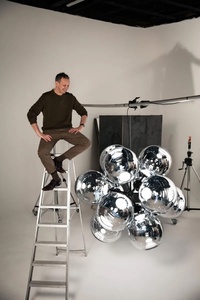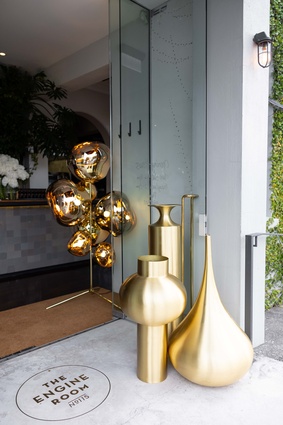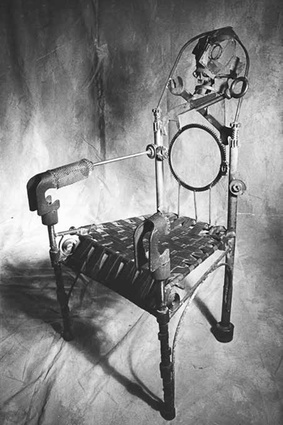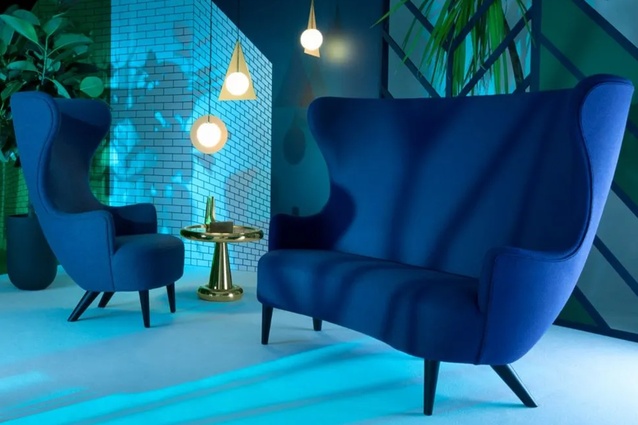Tom Dixon in conversation with Jessica Barter
British lighting, furniture and accessories designer Tom Dixon is currently in New Zealand as a guest of ECC and while in Auckland, Jessica Barter, director of Bureaux, sat down with him as ArchitectureNow’s roving reporter.
Jessica Barter: Tell me about the structure of your studio, where do your team physically work and are the Tom Dixon brand and the research and interiors sides separate businesses?
Tom Dixon: It’s not really a studio, it’s a business which is majority-owned by British investment firm NEO. And it’s a brand. Because we do our own distribution, marketing, logistics and finance, there’s 100 people in that part of the company, with an office in New York and one in Hong Kong, of which only two are product designers and maybe eight are interior designers. So, although it looks like a design company, the design proportion is maybe a 10th of the personnel. Then on top of that, there are 45 people that are in the restaurant in the HQ. So the business is not a studio, it is a label that does its own communication, its own product development. There are three distinct parts to the business. One which is services, which is architecture and branding, with two product designers, and that’s where I spend most of my time. Then there’s the brand vehicle, if you like, which is mainly people that do customer service and retail and the shop and online and all the other support services. And then there’s the restaurant, which is separate and distinct because it acts in a different way and has different challenges, different way of counting.

Jessica Barter: What was the idea behind the restaurant? When did this start?
Tom Dixon: Our studio before this one was in what used to be Virgin Records. It was Branson’s British headquarters. He must have had 200 staff there and he had a staff canteen, which all the pop stars went to, like the Rolling Stones, Robbie Williams, the Sex Pistols. It had a big commercial kitchen behind it and we were going to rip that out and make that into a furniture showroom. And I thought, why would you? Nobody can afford to eat restaurant food at every lunchtime, and so it was open to the public. I looked for a chef and the only one that I saw that I liked didn’t want to do a restaurant, he wanted to do a cookbook. I’d just employed his sister as a waitress, and he was in the kitchen. It was 20 covers and every day, we’d cook something different. It was fantastic. Wonderful. And that was my favourite moment of the restaurant.
We were in a kind of tertiary location, and it was like, how are we going to get people to come? And so the restaurant was a bit of a draw and at least allowed us to entertain customers if they bothered to come. And then it got a great review somewhere in The Sunday Times with a critic who never gave good reviews and suddenly it was flooded with people. So, my logic was partly to do with, having worked a lot in Italy, the idea of food and design overlapping. You spend a lot of time in restaurants, discussing design, and there were staff canteens in the factories, where the bosses and the workers would sit together, and I thought that was kind of cute. And then, as it progressed, it was clear to me that it was a better way of keeping a place alive than coming in and buying a table once every 20 years or so, where it’s never going to be a vibrant environment. Now it’s got to the stage where we have 2000 people a week spending 2.5 hours with us, which I think is a better way of testing out furnishing.
Jessica Barter: It’s a super interesting idea, there’s a generosity to it and I imagine it must be extremely beneficial to relationships both internally and externally. What is your design process with your team? You’ve got two product designers and eight interior designers. In terms of you personally and the generation of a large body of work, what is that process? Do you generate all of the initial ideas yourself?
Tom Dixon: Yeah, realistically, we’ve probably now, after 20 years, got a collection size which is as much as we can handle, Not as much as I’d like to do but the problem as you get bigger is that you have to buy more and more stock. We can’t really go beyond, like 600 references in the collection, if you include colour variants and what have you. You’re locked into this monster amount of stock to keep the whole machine going. So, there’s limits to what we can do, particularly in categories, and I used to really enjoy it. I’d go “can’t we just do more textiles or let’s do candles” and we’d do it and there was room to do it. Now, you have to take something out before you put something in. So the rate at which you can design for this has gone down but we compensate by designing and licensing out things which we wouldn’t really be able to distribute. So something logical might be a bathroom collection, which we would never be able to do through our infrastructure or sell in the same distribution and now we do it as a license.
Jessica Barter: When you decide to design something new, is that an idea that is generated collaboratively as a team or do you bring something to the table? What is your role in the process?
Tom Dixon: The team would be the product development department and some of the commercial people as well. My role is the same as it ever was in a way. I don’t have a conventional way of doing stuff because I was never trained. I tend not to do sketches, I tend to do models, full-size, in whatever’s around. I think I can use a glue gun, yeah.
When I started, I had a welding shop and a lot of machinery and I could do more. I could just make the real thing. Now, there is a kind of a battle for me to try and kick the kids off the computer and get them down in the tiny little workshop and actually make the stuff for real. And it sort of bounces back and forth between the computer and real-life models. But I refuse to accept something until I’ve seen it in the flesh, on the floor.
And from the idea generation perspective, it’s a kind of combination. You’ve got to follow your nose a bit but it’s almost like the more you know, the more kind of conservative you get, you know what I mean? And then the amount of information there is around in this day and age is kind of terrifying because you don’t know what’s your own idea anymore. And you’re surrounded by visual overload. So I try and get myself out of design and think of other things. We have an interior design facility and often the stuff is coming from live projects and that seems to be a really good way of generating ideas because you’re faced with real-life situations. And weirdly, not a lot of other brands have got interior design studios, partly I guess, because that would be competing against their own clientele. But for me, it seems fundamental to really knowing what you’re doing and being up to date on the price of everything and what clients will accept and how things function for real. And like I say, some things have come from that. That chair came from doing the Soho House project ages ago because I wanted to do 10 versions of antique wingbacks.

Jessica Barter: So these clients that you have where you’re doing interiors and you’re creating bespoke furniture for their project, what’s the agreement there? If you then want to take that and turn it into a Tom Dixon product.
Tom Dixon: Like a photographer, intellectual property belongs to us. We might say you can have it exclusive for two years or whatever but 90% of what we do is furniture and lighting, then that’s what we try and preserve.
Jessica Barter: How has your relationship with the physical act of making changed over the years, you mentioned you have a smaller workshop now than you used to?
Tom Dixon: When I first started, the thing was making the real thing, so you could call it craft and I was never a good craftsman, but it was basically just metal bashing. And I taught a lot of people how to do that. I had a flow of kids came through the workshop that have now gone on to do other things. And that was a long time ago. So that’s how I started. It was really just making things, not drawing them up and then making them, not waiting for a commission, just making stuff. And that’s kind of what I still do. But it’s tempered by the reality of manufacturing. Well, it was always tempered by the reality of what my machines would be able to do. And then, more knowledge on commerce and industrial production that I learned through mainly working with Habitat, which was owned by IKEA at the time. It’s no longer really a thing, Habitat, but it was a chain of 70 stores. And so I got access to everything in the world of home, from a duvet cover to a cuddly toy. I got a really sound understanding of the world of manufacturing and then also the world of consumption, so that’s what people actually buy. In retail, you get all of those figures all the time, every day. Like, “that’s taken off, that’s not taken off”.
Jessica Barter: And is it disappointing, the things that do sell in higher quantities?
Tom Dixon: I mean, yes and no. You get it wrong. What’s interesting is the people that think they really know what’s going to take off, just don’t either. You know, people who should know, the merchandisers, the risk people, so, yeah, I mean, it’s guesswork, really.
Jessica Barter: So this making exploration – how are you limited by your own skill set? You’ve worked across a whole range of different materials – stone and ceramic and glass and metal, obviously – in terms of how you explore a new material language. Is there a relationship between what you know how to do and manipulate in the workshop and what you’re interested in?
Tom Dixon: What I do isn’t really that complicated. Most of it’s not really pushing the boundaries of manufacturing technology. It’s expressive. It’s minimal-ish. It’s quite basic in terms of things. But there’s not really a lot of new possibilities. There’s more digital manufacturing, but it tends to be mimicking – apart from rapid prototyping and nobody wants to buy the plastic from that – it tends to be mimicking what’s gone before. The only thing that’s really progressed in interiors has been LED, where the kind of transition from electrical lighting to electronic lighting is really exciting. But then you’re working with experts in that, you’re not inventing the LED, you’re just using it, right? So it’s literally not rocket science.
Jessica Barter: When you have a model and a practice of your own that’s around making, obviously metal work in your earlier days, and then you think, okay, now I want to make a beautiful collection of marble. How does one decide they want to do a collection in marble and then prototype those things?
Tom Dixon: Well, I’ve been to probably 20 or 30 different stone factories in my time and I just know what they do. And then if something new happens, I’m interested in that. So now it’s all 3D milling and stuff, you can pretty much do anything. So the limitations of the material are probably slightly less than they were before, when everything had to be hand done. And then when I can, probably not with marble because I’ve got tennis elbow, then I just pile in and try and make it myself and see what happens. I’d love to do more, every time, but it’s worse than tennis because it’s so repetitive.
Jessica Barter: Is your tennis elbow from tennis?
Tom Dixon: No, I think it was from banging metal. It was actually from hammering.

Jessica Barter: What is the conversation that you’re having within your business at the moment around sustainable practice?
Tom Dixon: Well, it’s a conversation which is slightly more from the exterior, you know, from customers, from government legislation, from the news, the state of the world and the rest of it. I think, ultimately, there’s so much greenwash talk around the subject, which I find slightly offensive in terms of a reality check. Me being here is not sustainable, right? I mean, it really isn’t. The one line which I know is correct is that ultimately, I live with my great-grandmother’s writing desk, which she bought as an antique, which must be Louis 16. So, that’s sustainable.
So, if you do your job properly and, I am now antique enough myself to see that stuff come back, in a sale room, in a car boot sale, on eBay, in antique shops actually, I’ve seen my stuff.
So you get better at predicting what’s going to last in terms of style and you definitely know what lasts in terms of materiality and build quality. And that’s what our ambition is, to have stuff that you don’t recycle. Everybody’s talking about recyclability but the reality is that hardly anybody does. It can be as recycled as you want and nobody’s going to take the thing apart, like take the foam to one recycling centre, metal to another, cloth to another one. It’s just not going to happen. Yet, they’re all recyclable. And then the other battle is trying to explain why more ecological materials are more expensive. We’ve got a collection of cork furniture which I’m very keen on and we spent a lot of time and energy working out the carbon footprint, blah de blah, and nobody really wants to pay the money that it is, because it’s associated with a throwaway material, meaning that cork from wine bottles, you just chuck them, right? So there’s a psychological problem there and that’s a carbon-positive material, right? So there’s education to be done, which I think, designers can do. And there’s things that we can do in terms of really understanding the impact of our manufacturing processes and, in terms of brands, we at least know and have visited exactly what happens in every factory and we try and minimise it as much as possible, but as a global furniture brand, probably just the transport is a shocker, if you were to measure it, we have to plant some more trees.
Jessica Barter: We have this difficulty here. We were working on a project recently where we thought we’ll try and use all materials from New Zealand and found a beautiful New Zealand stone and there was just no way to get it cut locally. And so we discovered that this was in fact getting shipped to China and cut and then shipped back to us. It’s difficult. Is there an object or a piece of furniture that you own which is most precious to you?
Tom Dixon: I try to be as little attached as possible, but it would be a shame if my great-grandmother’s writing desk collapsed or something. I mean, it’s already got water damage and I feel a bit guilty about that. I don’t do a lot of writing on it but I stick my computer on it from time to time. It’s a very attractive piece of joinery, black lacquer and gold and little bronze bits and pieces, like hinges.
Jessica Barter: What haven’t you made that you would like to?
Tom Dixon: I mean, almost everything that I haven’t made, I’d quite like to have a go. I’d quite like to get into city planning or something big-scale, like tunnels. But if you’re talking about products, I mean, that’s the beauty of the design process, everything’s designed, isn’t it? I’d love to do some transport. I haven’t actually done any electronics, which is annoying because, they dominate modern life. And I think I could do a different phone, that’s for sure. It doesn’t take much to get away from what everybody else is doing.
But I think there’s a multitude of things that I’d love to have a go at and the problem is always trying to avoid being pigeonholed as the person that does, at the moment I guess it’s metallic lights. But I’ve been a person who does things out of rusty metal. I’ve been all kinds of different designers before. So I hope I can break out of my pigeonhole and do some other stuff and probably some more useful stuff might be good. But I’ve done one house and I’d like to do more architecture. It was for a client in Monaco.
Jessica Barter: Cool. I would love to see that.
Tom Dixon: It’s quite concretely.
Jessica Barter: What was the big shift for you doing a piece of architecture as opposed to the interiors.
Tom Dixon: Delegation really, because you’ve probably trained for seven years or something and I haven’t. You really do have to get structural engineers and other architects involved and really not do so much yourself. But I learned a lot from it and I really wouldn’t do the same thing again. I’d do it in a different way. And I’ve also done my own – where I live now in London. It’s kind of a converted water tower. It’s not newly built but that was prefabricated architecture, which becomes a lot more like product at that point.
Jessica Barter: I have a question that I’m sure everyone asks you, which I feel like I should ask you, what is your advice to up and coming designers who are wanting to reach your level of success.
Tom Dixon: I mean, success is sort of relative, isn’t it? I still think I’ve only just started personally in terms of what I could be doing. My advice is usually just that they’ve got to find their difference. People tend to sort of ask how they could be me and they’re not going to be, are they? Because that’s already done and you don’t want to be that. So it’s more about finding and being able to project their own uniqueness of why they’re different, rather than why they’re the same. I think it’s much harder now, I think, with the assault of information to really be anonymous and develop a kind of aesthetic that isn’t kind of common. And there’s many more practitioners as well now than when I started. So I think the difficulty is really just finding a niche that you can own. And particularly when you go abroad, people are more wanting to be international style. And I think local difference is good. I think personal experience is good. And then not just being interested in design is good. You know, you go to car companies, right? And those boys that work in those car companies have literally only been reading car magazines and dreaming about being a car designer since, you know, a long time. So all they do is produce another car that looks like a car that is for car buffs. And think that half the people in the world are not boys and half, you know, maybe 90% of the remaining ones are really not that interested in cars. So there’s space for people to be different in almost every sector, I think.
Jessica Barter: Yeah, it seems like a difficult task these days to find a space and design that hasn’t been done.
Tom Dixon: You know, I’d imagine that most of the kids that are probably creative and brilliant right now are off in the digital sphere doing really new stuff but I don’t even know about it. So there is space for originals, but I think the originality is the thing that you’ve got to find.
Jessica Barter: What motivates and excites you at this point of your career?
Tom Dixon: Covid was kind of interesting because I’m a kind of city boy and I was going mad at home because we had a harsh lockdown at the beginning. Not as harsh as yours. But I had some friends that have an orchid greenhouse, like an industrial one, not a domestic one. Like a proper production unit. I had lots of empty, empty greenhouses and horticulture we were allowed to do, right? So like, I’m out of here. I grew a lot of tomatoes and cannabis and escaped to the greenhouse and I just made things myself. And so what excited me was really the luminosity and also the amount of space there is in a greenhouse, you know. Cheap, affordable space compared to London. So in London, my studio headquarters is £80 a square foot and in the countryside it’s £5 a square foot. So you’re back to this thing of being able to like loads of space, free materials that were everywhere, you know, broken glass, bamboo sticks, mud. And I went completely feral, basically. So that excited me. And then I did a pop-up flower shop and a pop-up pizzeria and a pop-up this and that, when it started relaxing a bit. And of course, garden centres were the first retail that opened in the UK as well because it’s mainly outdoors and I enjoyed that Covid experience immensely actually.
Jessica Barter: That’s a great place to end I think. Thank you very much, that was super interesting.
















